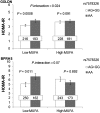Modulation by dietary fat and carbohydrate of IRS1 association with type 2 diabetes traits in two populations of different ancestries
- PMID: 23596181
- PMCID: PMC3747864
- DOI: 10.2337/dc12-2607
Modulation by dietary fat and carbohydrate of IRS1 association with type 2 diabetes traits in two populations of different ancestries
Abstract
Objective: Insulin receptor substrate 1 (IRS1) is central to insulin signaling pathways. This study aimed to examine the association of IRS1 variants with insulin resistance (IR) and related phenotypes, as well as potential modification by diet.
Research design and methods: Two IRS1 variants (rs7578326 and rs2943641) identified by genome-wide association studies as related to type 2 diabetes were tested for their associations with IR and related traits and interaction with diet in the Genetics of Lipid Lowering Drugs and Diet Network (GOLDN) study (n = 820) and the Boston Puerto Rican Health Study (BPRHS) (n = 844).
Results: Meta-analysis indicated that rs7578326 G-allele carriers and rs2943641 T-allele carriers had a lower risk of IR, type 2 diabetes, and metabolic syndrome (MetS). Significant interactions on IR and MetS were found for these two variants and their haplotypes with diet. In GOLDN, rs7578326 G-allele carriers and rs2943641 T-allele carriers and their haplotype G-T carriers had a significantly lower risk of IR and MetS than noncarriers only when the dietary saturated fatty acid-to-carbohydrate ratio was low (≤ 0.24). In both GOLDN (P = 0.0008) and BPRHS (P = 0.011), rs7578326 G-allele carriers had a lower risk of MetS than noncarriers only when dietary monounsaturated fatty acids were lower than the median intake of each population.
Conclusions: IRS1 variants are associated with IR and related traits and are modulated by diet in two populations of different ancestries. These findings suggest that IRS1 variants have important functions in various metabolic disorders and that dietary factors could modify these associations.
Figures

Similar articles
-
Interaction of an S100A9 gene variant with saturated fat and carbohydrates to modulate insulin resistance in 3 populations of different ancestries.Am J Clin Nutr. 2016 Aug;104(2):508-17. doi: 10.3945/ajcn.116.130898. Epub 2016 Jul 20. Am J Clin Nutr. 2016. PMID: 27440084 Free PMC article. Clinical Trial.
-
Genetic variants at PSMD3 interact with dietary fat and carbohydrate to modulate insulin resistance.J Nutr. 2013 Mar;143(3):354-61. doi: 10.3945/jn.112.168401. Epub 2013 Jan 9. J Nutr. 2013. PMID: 23303871 Free PMC article.
-
Sex-specific interactions between the IRS1 polymorphism and intakes of carbohydrates and fat on incident type 2 diabetes.Am J Clin Nutr. 2013 Jan;97(1):208-16. doi: 10.3945/ajcn.112.046474. Epub 2012 Dec 5. Am J Clin Nutr. 2013. PMID: 23221578
-
Polyunsaturated Fatty Acids Modulate the Association between PIK3CA-KCNMB3 Genetic Variants and Insulin Resistance.PLoS One. 2013 Jun 27;8(6):e67394. doi: 10.1371/journal.pone.0067394. Print 2013. PLoS One. 2013. PMID: 23826284 Free PMC article.
-
Diet and risk of Type II diabetes: the role of types of fat and carbohydrate.Diabetologia. 2001 Jul;44(7):805-17. doi: 10.1007/s001250100547. Diabetologia. 2001. PMID: 11508264 Review.
Cited by
-
Gene-Diet Interactions in Type 2 Diabetes: The Chicken and Egg Debate.Int J Mol Sci. 2017 Jun 2;18(6):1188. doi: 10.3390/ijms18061188. Int J Mol Sci. 2017. PMID: 28574454 Free PMC article. Review.
-
Association Study with 77 SNPs Confirms the Robust Role for the rs10830963/G of MTNR1B Variant and Identifies Two Novel Associations in Gestational Diabetes Mellitus Development.PLoS One. 2017 Jan 10;12(1):e0169781. doi: 10.1371/journal.pone.0169781. eCollection 2017. PLoS One. 2017. PMID: 28072873 Free PMC article.
-
Genotype-based precision nutrition strategies for the prediction and clinical management of type 2 diabetes mellitus.World J Diabetes. 2024 Feb 15;15(2):142-153. doi: 10.4239/wjd.v15.i2.142. World J Diabetes. 2024. PMID: 38464367 Free PMC article. Review.
-
Nutrigenomics, the Microbiome, and Gene-Environment Interactions: New Directions in Cardiovascular Disease Research, Prevention, and Treatment: A Scientific Statement From the American Heart Association.Circ Cardiovasc Genet. 2016 Jun;9(3):291-313. doi: 10.1161/HCG.0000000000000030. Epub 2016 Apr 19. Circ Cardiovasc Genet. 2016. PMID: 27095829 Free PMC article. Review.
-
Genome-wide interaction of genotype by erythrocyte n-3 fatty acids contributes to phenotypic variance of diabetes-related traits.BMC Genomics. 2014 Sep 11;15(1):781. doi: 10.1186/1471-2164-15-781. BMC Genomics. 2014. PMID: 25213455 Free PMC article.
References
-
- Centers for Disease Control and Prevention. National Diabetes Fact Sheet: United States 2011 Atlanta, Centers for Disease Control and Prevention, U.S. Department of Health and Human Services, 2011
-
- Shaw JE, Sicree RA, Zimmet PZ. Global estimates of the prevalence of diabetes for 2010 and 2030. Diabetes Res Clin Pract 2010;87:4–14 - PubMed
-
- Grundy SM, Cleeman JI, Daniels SR, et al. American Heart Association. National Heart, Lung, and Blood Institute Diagnosis and management of the metabolic syndrome: an American Heart Association/National Heart, Lung, and Blood Institute Scientific Statement. Circulation 2005;112:2735–2752 - PubMed
Publication types
MeSH terms
Substances
Grants and funding
- R01 HL091357/HL/NHLBI NIH HHS/United States
- P01AG023394/AG/NIA NIH HHS/United States
- P50HL105185/HL/NHLBI NIH HHS/United States
- R01 HL078885/HL/NHLBI NIH HHS/United States
- HL54776/HL/NHLBI NIH HHS/United States
- U01 HL072524/HL/NHLBI NIH HHS/United States
- HL078885/HL/NHLBI NIH HHS/United States
- L60 MD003562/MD/NIMHD NIH HHS/United States
- R01 HL054776/HL/NHLBI NIH HHS/United States
- K08 HL112845/HL/NHLBI NIH HHS/United States
- P50 HL105185/HL/NHLBI NIH HHS/United States
- P01 AG023394/AG/NIA NIH HHS/United States
LinkOut - more resources
Full Text Sources
Other Literature Sources
Medical
Molecular Biology Databases
Miscellaneous

